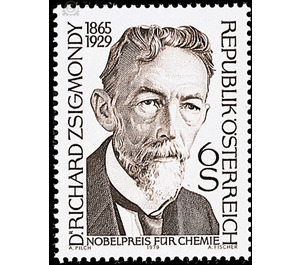50th anniversary of death - Austria / II. Republic of Austria 1979 - 6 Shilling
Theme: Well-known people
| Country | Austria / II. Republic of Austria |
| Issue Date | 1979 |
| Face Value | 6.00 |
| Color | brown |
| Printing Type | Typography |
| Stamp Type | Commemorative |
| Item Type | Stamp |
| Chronological Issue Number | 964 |
| Chronological Chapter | OOS-OE2 |
| SID | 917268 |
| In 63 Wishlists | |
Richard Zsigmondy was born on April 1, 1865 in Vienna. After completing his school leaving exam, he began studying chemistry at the Vienna University of Technology, continuing his studies in Munich, where he completed his doctoral thesis "Contributions to the Synthesis of Indene Derivatives" in the laboratory of Wilhelm Miller. In 1893 he completed his habilitation at the Technical University in Graz where he also worked as a private lecturer for several years. From 1897 he was a research assistant at Jenaer Glaswerk Schott u. Gene. There he dealt mainly with the gold ruby glass and the related question of the solubility of metals in glass. The recognition, which found his work, meant that he was appointed from 1907 as Associate Professor of Inorganic Chemistry to Göttingen. There he worked, from 1917 as a full professor, until his death on 23 September 1929. He was awarded the Nobel Prize for Chemistry in 1925. He received it "for the demonstration of the heterogeneity of the colloidal solutions and for the applied methods, which were fundamental for modern colloid chemistry".


